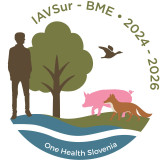About the project

The IAVSur – BME is a three-year project (2024-2026) which aims to contribute to the setting and scaling up of animal health and environmental surveillance system, including the systematic collection of data. It focuses on surveillance for Influenza A Viruses in Mammals, and Environment.
The project IAVSur - BMI is based on the following segments of IAV ecology:
- Wild mammals
- Domestic mammals
- Environment
By bridging veterinary science, biology and environmental science it aims at providing the missing link to achieve a better understanding of the whole range of IAV ecology and better apprehend the risk and impact on the animal and human health.
Besides that, this project will lead to improved collaboration at multiple organization levels and harmonized approach to the complex ecology of IAVs and will enable prioritization of future surveillance and research agendas, under One Health approach. This will provide evidence and methods to support decision-making and prioritize actions at the national and EU level.
Five organisations are taking part in the project: Administration for Food Safety, Veterinary Sector and Plant Protection, University of Ljubljana (Veterinary Faculty, National Veterinary Institute), National Institute of Biology, National Institute of Public Health and National Laboratory of Health, Environment and Food.
Specific objectives
The IAVSur – BME takes a multi-sectoral and transdisciplinary approach to the monitoring of IAV infections in wild mammals, pigs, and environment. It will enhance cross-sector cooperation at the interface of veterinary, biology, environmental activities, and public health to reach a better understanding of monitoring mechanisms of influenza viruses in animal populations and environment to provide baseline information for assessment of IAV epidemiological situation.
Specific objective 1: Determine the prevalence of IAV in the selected wild mammals and to predict possible mammal adaptations and zoonotic potential of detected viruses by WGS and data analysis. Perform molecular epidemiology to research possible co-circulation of IAV between birds, mammals, and humans.
Specific objective 2: Determine the concentration of IAV in selected environmental waters and try to find the correlations between the outbreaks of AIV and the contamination of the environment water areas by AIV. Use of IAV positive water samples as matrix for WGS and therefore enhance the detection of potential viral mutations and recombination.
Specific objective 3: Establish a system to raise awareness among owners and veterinarians about the necessity of identifying swIAV in pigs with a respiratory clinical picture. Identify possible viral 'adaptive mutations' and recombination of swIAV that may pose enhanced zoonotic potential by WGS and molecular epidemiology. Identify environmental samples from the farm as possible diagnostic samples and establish a system of non-invasive sampling for swIAV on farms with a respiratory clinical picture.
Specific objective 4: Enhance the preparedness to possible human health threat that animal IAV represent because of their recombination and mutations that may result in variants with zoonotic potential that may lead to higher rate of human infections or even pandemics. Existing algorithms for managing cases of suspected infection with animal IAV in humans will be reviewed and amended, if needed. Methods used for detection of IAV in humans will be checked for coverage of circulating animal IAV. That will be supported by a data sharing network between the veterinarian and human health authorities that will enable rapid sharing of results of detection of IAV with enhanced zoonotic potential in animals, higher rates of infections of mammals with AIV and detections of animal infections with human IAV as well as detection of any zoonotic events in humans.
Work packages (WP)
WP1
The overall objective is to ensure efficient and timely project implementation, support responsible implementation of activities and provide support to partners, as well as ensure that project tasks are completed on time and within budget, communicate with partners and with EFSA and HaDEA, and be aware of potential risks and conflicts and mitigate them promptly and appropriately.
Leader: Aleksandra Hari
WP2
Under WP2 surveillance of IAV in wild mammals, carnivorous and omnivorous species, especially red foxes, and wild boars, will be established. The combination of active and passive surveillance will address prevalence of infection as investigated by detection of antibodies against IAV as well as IAV detection and characterisation by molecular and virological methods. The goal is to use a representative sample for each selected species collected in regions with a history of AI outbreaks.
Leader: Brigita Slavec
WP3
Within this WP the monitoring of environmental samples for the presence of IAV will be established. Sampling will focus on water samples (and associated sediment samples) obtained from water bodies with high density of migrating and wintering water bird populations and with ongoing or otherwise with history of known outbreaks of IAV (based on present and past surveillance data). This kind of monitoring, also known as water-based epidemiology, represents an alternative to other approaches, which is not dependent on efforts linked with caught or dead animals and will provide independent insights into the appearance and epidemiology of the virus in an area linked with analysed samples.
Leader: Ion Gutierrez Aguirre
WP4
The WP focuses on determining the presence of IAV in domestic pigs. The epidemiology of swine influenza includes viruses of human, avian, and porcine origin. Pigs may play an important role as the intermediate host for other species, where reassortment and/or adaptation events occur. One of the goals is to determine which viral subtypes are circulating and are most prevalent in the pig population. Through targeted surveillance of pig farms, we will collect nasal and environmental samples for detection and subtype characterization by molecular and virological methods.
Leader: Marina Štukelj







